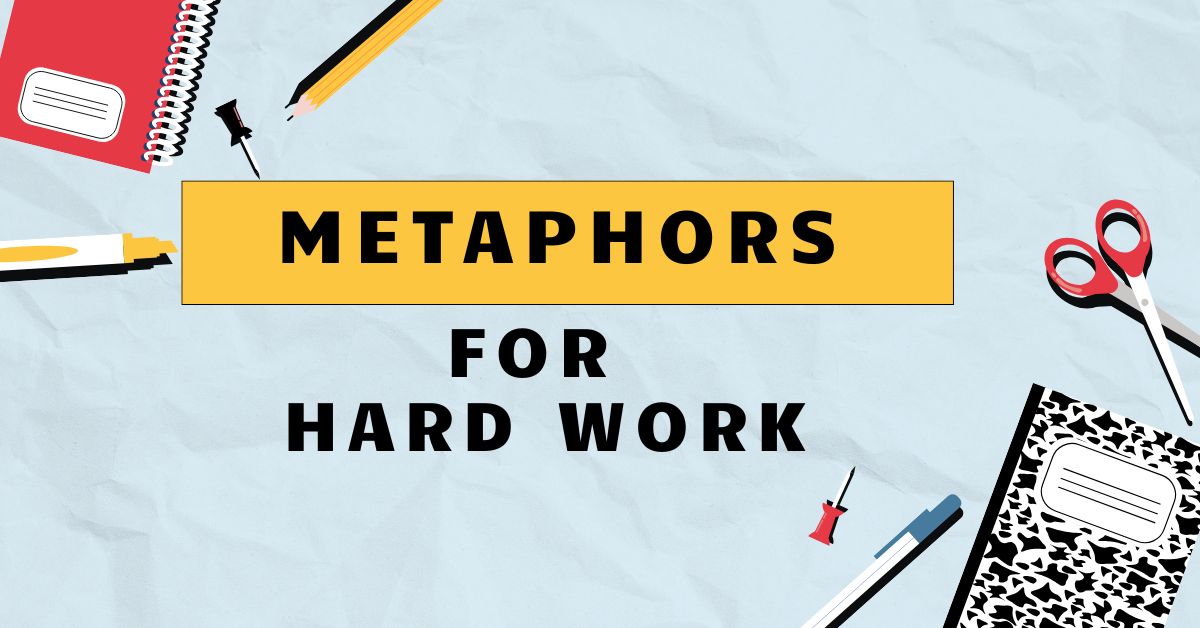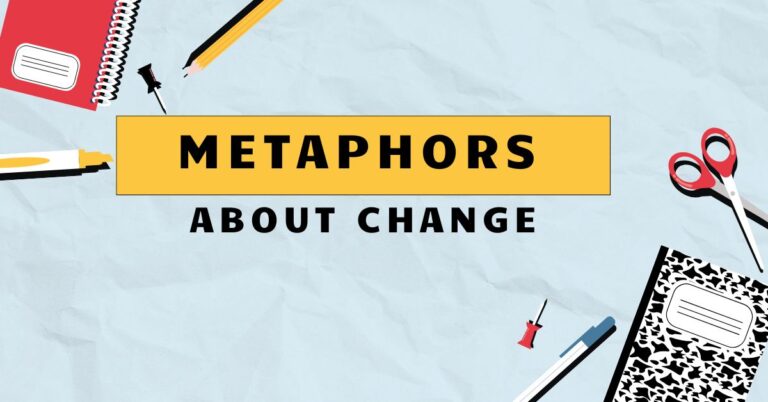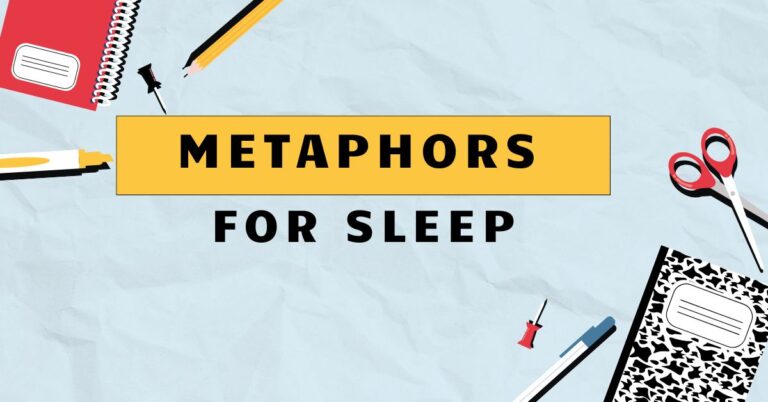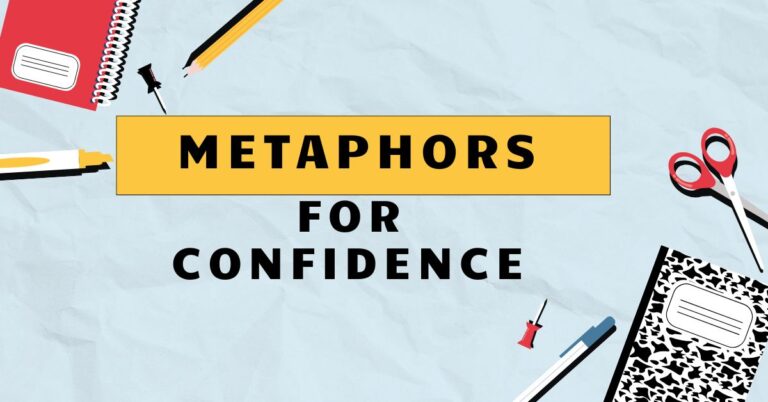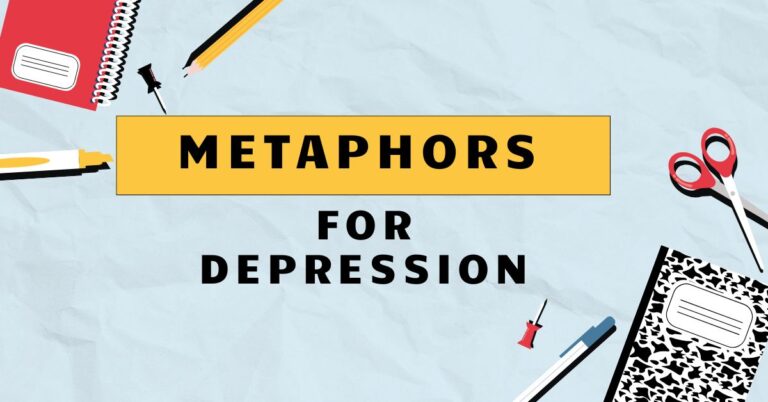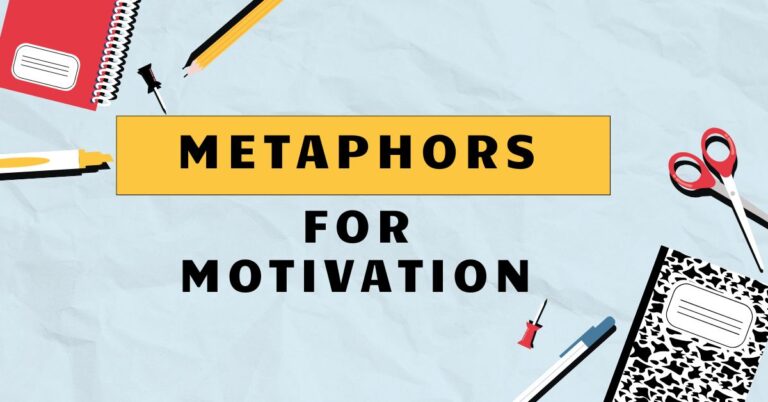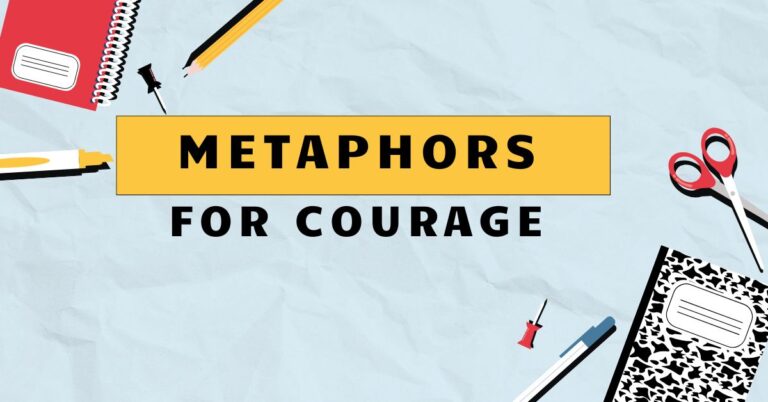31 Metaphors for Hard Work: A Comprehensive Guide
Understanding metaphors for hard work is crucial for grasping nuanced communication and enriching your English vocabulary. Metaphors paint vivid pictures, making abstract concepts like effort and dedication more relatable.
This guide will explore various metaphors used to describe hard work, their structural elements, and how to use them effectively. This article is designed for English language learners, writers, and anyone looking to enhance their understanding of figurative language.
Table of Contents
- Introduction
- Definition of Metaphor and Hard Work
- Structural Breakdown of Hard Work Metaphors
- Types and Categories of Hard Work Metaphors
- Examples of Hard Work Metaphors
- Usage Rules for Hard Work Metaphors
- Common Mistakes with Hard Work Metaphors
- Practice Exercises
- Advanced Topics in Hard Work Metaphors
- Frequently Asked Questions
- Conclusion
Definition of Metaphor and Hard Work
Ametaphoris a figure of speech that directly compares two unrelated things, suggesting a similarity between them. It asserts that one thingisanother, not literally, but in a figurative sense to highlight shared qualities or characteristics.
Unlike similes, which use “like” or “as” to make comparisons, metaphors imply the comparison directly.
Hard work, in the context of this article, refers to sustained effort and diligence applied towards achieving a goal. It encompasses physical, mental, and emotional exertion, often involving challenges, obstacles, and the need for perseverance.
It’s not merely about activity, but about purposeful, dedicated action.
When we combine these two concepts, we get metaphors for hard work, which are figurative expressions that describe effort and dedication by comparing them to something else. These metaphors often draw upon imagery of physical labor, endurance, growth, or overcoming obstacles to convey the intensity and nature of the work involved.
Structural Breakdown of Hard Work Metaphors
Understanding the structure of a metaphor involves recognizing its two key components: thetenorand thevehicle. The tenor is the subject being described (in this case, hard work), and the vehicle is the object or concept used to describe it.
The connection between the tenor and vehicle is the shared characteristic or quality that the metaphor highlights.
For example, in the metaphor “He is a workhorse,” the tenor is the person who is working hard, and the vehicle is the “workhorse.” The shared characteristic is the quality of being strong, tireless, and dedicated to labor. The effectiveness of a metaphor lies in how well the vehicle conveys the intended meaning about the tenor.
Metaphors can also be extended, meaning they are developed beyond a single phrase or sentence. An extended metaphor draws out multiple points of comparison between the tenor and the vehicle, creating a richer and more detailed image.
This can be particularly effective in conveying the complexities of hard work.
Types and Categories of Hard Work Metaphors
Metaphors for hard work can be categorized based on the imagery they evoke. Here are some common categories:
Physical Labor Metaphors
These metaphors draw upon the imagery of manual labor, construction, or other physically demanding activities. They emphasize the exertion and effort involved in hard work.
Endurance Metaphors
These metaphors focus on the aspect of perseverance and the ability to withstand challenges and difficulties. They highlight the mental and emotional fortitude required for hard work.
Growth Metaphors
These metaphors compare hard work to the process of growth, cultivation, or development. They emphasize the idea that effort leads to positive outcomes and progress over time.
Obstacles and Challenges Metaphors
These metaphors portray hard work as a struggle against obstacles, challenges, or adversity. They highlight the resilience and determination needed to overcome difficulties.
Tools and Machinery Metaphors
These metaphors use the imagery of tools, machines, or instruments to represent hard work. They emphasize the efficiency, precision, or effectiveness of focused effort.
Examples of Hard Work Metaphors
Here are some examples of hard work metaphors, categorized by type:
Physical Labor Metaphors Examples
The following table illustrates metaphors that describe hard work through the lens of physical labor.
| Metaphor | Explanation |
|---|---|
| He’s been toiling away at the project. | “Toiling” evokes images of strenuous physical labor, suggesting the person has been working very hard. |
| She’s digging deep to finish the report. | “Digging deep” implies a forceful and determined effort, like excavating something difficult. |
| They’re laying the foundation for future success. | “Laying the foundation” compares hard work to the essential task of constructing a building’s base. |
| He’s carrying the weight of the entire company. | “Carrying the weight” suggests a heavy burden and responsibility, implying significant effort. |
| She’s plowing through the data. | “Plowing” suggests moving forcefully and steadily through a large amount of material. |
| He’s sweating blood to meet the deadline. | “Sweating blood” is a hyperbole emphasizing the extreme effort and stress involved. |
| She’s hammering out the details. | “Hammering out” suggests forcefully working through problems to reach a solution. |
| They’re building bridges with their hard work. | “Building bridges” implies connecting different elements through dedicated effort. |
| He’s moving mountains to get the job done. | “Moving mountains” suggests overcoming seemingly insurmountable obstacles. |
| She’s shouldering the responsibility. | “Shouldering” implies taking on a heavy burden and responsibility. |
| He’s grinding away at his studies. | “Grinding away” suggests continuous, repetitive, and often tedious hard work. |
| She’s hauling the team forward. | “Hauling” implies pulling or dragging something heavy, suggesting a strong leading effort. |
| He’s chipping away at the problem. | “Chipping away” suggests making slow but steady progress by removing small pieces. |
| She’s constructing a new future. | “Constructing” implies building or creating something significant through effort. |
| He’s laying the groundwork for success. | “Laying the groundwork” implies preparing the foundation for future achievements. |
| She’s lifting the team to new heights. | “Lifting” implies elevating or raising the team to a higher level of performance. |
| He’s paving the way for innovation. | “Paving the way” implies making it easier for others to follow and innovate. |
| She’s tilling the soil for new ideas. | “Tilling the soil” suggests preparing for new growth and opportunities. |
| He’s digging in his heels to get it done. | “Digging in his heels” implies resisting opposition and persevering through hard work. |
| She’s brick by brick, building her empire. | Emphasizes the slow, methodical, and sustained effort required to build something great. |
| He’s wrestling with the code. | Implies a direct, physical, and intense struggle with a complex problem. |
| She’s sculpting her masterpiece. | Suggests careful, deliberate, and creative hard work to achieve perfection. |
| He’s mining for gold in the data. | Implies searching diligently for valuable insights within a large dataset. |
Endurance Metaphors Examples
The following table showcases metaphors that equate hard work with endurance and perseverance.
| Metaphor | Explanation |
|---|---|
| He’s running a marathon, not a sprint. | This compares hard work to a long-distance race, emphasizing the need for sustained effort. |
| She’s weathering the storm. | “Weathering the storm” suggests enduring difficult circumstances and challenges. |
| He’s pushing through the pain. | “Pushing through the pain” highlights the ability to overcome discomfort and hardship. |
| She’s staying the course. | “Staying the course” implies remaining committed to a goal despite difficulties. |
| He’s fighting an uphill battle. | “Fighting an uphill battle” suggests facing significant challenges and opposition. |
| She’s holding on for dear life. | “Holding on for dear life” emphasizes the desperation and effort to maintain progress. |
| He’s keeping his head above water. | “Keeping his head above water” implies struggling to stay afloat and manage difficulties. |
| She’s standing her ground. | “Standing her ground” suggests resisting pressure and maintaining her position. |
| He’s bearing the burden. | “Bearing the burden” implies carrying a heavy load and responsibility. |
| She’s persevering through adversity. | “Persevering” highlights the determination to continue despite obstacles. |
| He’s going the extra mile. | “Going the extra mile” suggests exceeding expectations and putting in additional effort. |
| She’s hanging in there. | “Hanging in there” implies enduring a difficult situation and not giving up. |
| He’s keeping the faith. | “Keeping the faith” suggests maintaining optimism and belief in the face of challenges. |
| She’s digging in for the long haul. | “Digging in” suggests preparing for a prolonged and difficult effort. |
| He’s enduring the hardship. | “Enduring” highlights the ability to withstand difficult circumstances. |
| She’s riding out the turbulence. | “Riding out” implies navigating through a period of instability and difficulty. |
| He’s withstanding the pressure. | “Withstanding” suggests resisting and overcoming external pressures. |
| She’s braving the storm. | “Braving” implies facing a difficult situation with courage and determination. |
| He’s pushing the envelope. | “Pushing the envelope” suggests exceeding limits and challenging boundaries. |
| She’s running on fumes. | Implies continuing to work despite being exhausted or depleted of resources. |
| He’s swimming against the tide. | Suggests facing opposition and working against prevailing trends. |
| She’s weathering the fire. | Implies enduring intense trials and emerging stronger. |
| He’s dancing in the rain. | Suggests finding joy and resilience even in difficult circumstances. |
Growth Metaphors Examples
The following table presents metaphors that link hard work to growth and development.
| Metaphor | Explanation |
|---|---|
| He’s planting the seeds of success. | This compares hard work to the act of planting, suggesting that effort will lead to future growth. |
| She’s nurturing her career. | “Nurturing” implies providing care and attention to foster growth. |
| He’s cultivating new skills. | “Cultivating” suggests developing and refining skills through dedicated effort. |
| She’s reaping the rewards of her labor. | “Reaping the rewards” compares hard work to harvesting the fruits of one’s efforts. |
| He’s blossoming into a leader. | “Blossoming” suggests developing and flourishing into a more capable individual. |
| She’s bearing fruit after years of hard work. | “Bearing fruit” implies producing positive results and outcomes. |
| He’s growing stronger every day. | “Growing stronger” suggests continuous improvement and development. |
| She’s reaching new heights. | “Reaching new heights” implies achieving greater levels of success and accomplishment. |
| He’s branching out into new areas. | “Branching out” suggests expanding into new opportunities and directions. |
| She’s taking root in the industry. | “Taking root” implies becoming established and secure in a particular field. |
| He’s germinating new ideas. | “Germinating” suggests developing and nurturing new concepts and innovations. |
| She’s flourishing in her role. | “Flourishing” implies thriving and excelling in a particular position. |
| He’s harvesting the benefits of his efforts. | “Harvesting” suggests gathering the positive outcomes of hard work. |
| She’s bearing the fruits of her labor. | “Bearing the fruits” implies producing positive results and outcomes. |
| He’s cultivating a strong team. | “Cultivating” suggests developing and nurturing a capable team. |
| She’s planting seeds of innovation. | “Planting seeds” implies initiating new ideas and innovations. |
| He’s nurturing a positive environment. | “Nurturing” suggests fostering a supportive and productive atmosphere. |
| She’s growing her network. | “Growing” implies expanding and strengthening professional connections. |
| He’s reaping the rewards of dedication. | “Reaping the rewards” compares hard work to harvesting the fruits of one’s efforts. |
| She’s blossoming into her full potential. | Implies developing and realizing one’s complete capabilities. |
| He’s watering the garden of his mind. | Suggests nourishing and developing one’s intellectual capacity through continuous learning. |
| She’s pruning away distractions. | Implies removing obstacles and focusing on essential tasks for growth. |
| He’s climbing the ladder of success. | Suggests progressing steadily towards higher achievements. |
Obstacles and Challenges Metaphors Examples
The following table illustrates metaphors that portray hard work as overcoming obstacles and challenges.
| Metaphor | Explanation |
|---|---|
| He’s battling his way to the top. | This compares hard work to a fight, emphasizing the struggle and effort required. |
| She’s overcoming adversity. | “Overcoming” implies successfully dealing with difficult circumstances. |
| He’s tackling the challenges head-on. | “Tackling” suggests addressing problems directly and forcefully. |
| She’s navigating through a maze. | “Navigating” implies finding a way through a complex and confusing situation. |
| He’s conquering his fears. | “Conquering” suggests overcoming and defeating personal limitations. |
| She’s scaling the corporate ladder. | “Scaling” implies climbing and progressing through a hierarchical structure. |
| He’s breaking down barriers. | “Breaking down” suggests overcoming obstacles and limitations. |
| She’s pushing past her limits. | “Pushing past” implies exceeding previous boundaries and capabilities. |
| He’s rising above the competition. | “Rising above” suggests outperforming and surpassing competitors. |
| She’s weathering the storm of criticism. | “Weathering the storm” suggests enduring difficult circumstances and challenges. |
| He’s navigating treacherous waters. | “Navigating” implies finding a way through difficult and dangerous situations. |
| She’s conquering her doubts. | “Conquering” suggests overcoming and defeating personal uncertainties. |
| He’s breaking through the glass ceiling. | “Breaking through” implies overcoming barriers to advancement. |
| She’s pushing through the obstacles. | “Pushing through” suggests overcoming difficulties and challenges. |
| He’s rising above the challenges. | “Rising above” suggests outperforming and surpassing difficulties. |
| She’s tackling the impossible. | “Tackling” suggests addressing seemingly insurmountable problems. |
| He’s overcoming setbacks. | “Overcoming” implies successfully dealing with temporary failures. |
| She’s navigating complex situations. | “Navigating” implies finding a way through intricate and challenging scenarios. |
| He’s conquering his weaknesses. | “Conquering” suggests overcoming and defeating personal limitations. |
| She’s swimming upstream. | Implies working against the current of popular opinion or established norms. |
| He’s climbing mount improbable. | Suggests attempting a task that seems nearly impossible. |
| She’s fighting through the red tape. | Implies navigating bureaucratic obstacles to achieve a goal. |
| He’s walking through fire. | Suggests enduring intense trials and emerging unscathed. |
Tools and Machinery Metaphors Examples
The following table presents metaphors that use tools and machinery to represent hard work.
| Metaphor | Explanation |
|---|---|
| He’s a well-oiled machine. | This compares a person to a machine that runs smoothly and efficiently, suggesting they are highly productive. |
| She’s a human dynamo. | “Dynamo” implies a source of energy and power, suggesting she is highly energetic and productive. |
| He’s firing on all cylinders. | “Firing on all cylinders” suggests functioning at maximum capacity and efficiency. |
| She’s sharpening her skills. | “Sharpening” implies improving and refining skills to enhance performance. |
| He’s fine-tuning the process. | “Fine-tuning” suggests making small adjustments to optimize performance. |
| She’s cranking out results. | “Cranking out” implies producing a large quantity of results efficiently. |
| He’s a workhorse. | “Workhorse” implies someone who is strong, reliable, and dedicated to hard work. |
| She’s greasing the wheels of progress. | “Greasing the wheels” suggests making progress smoother and easier. |
| He’s a cog in the machine. | “Cog in the machine” implies playing a small but essential role in a larger system. |
| She’s drilling down into the details. | “Drilling down” suggests examining details thoroughly and deeply. |
| He’s revving up for the challenge. | “Revving up” implies preparing and energizing for a difficult task. |
| She’s a well-oiled engine. | “Well-oiled engine” implies functioning smoothly and efficiently. |
| He’s a powerhouse of productivity. | “Powerhouse” implies a source of great energy and productivity. |
| She’s streamlining the workflow. | “Streamlining” suggests making processes more efficient and effective. |
| He’s a driving force behind the project. | “Driving force” implies a strong influence and motivation behind an initiative. |
| She’s a catalyst for innovation. | “Catalyst” implies someone who accelerates and inspires new ideas. |
| He’s a precision instrument. | “Precision instrument” implies accuracy and effectiveness in execution. |
| She’s a human calculator. | Implies someone with exceptional analytical and numerical skills. |
| He’s a Swiss Army knife of skills. | Suggests possessing a wide range of versatile abilities. |
| She’s a laser focused on the task. | Implies intense concentration and dedication to a specific goal. |
| He’s sharpening his axe. | Suggests preparing and refining skills for future challenges. |
| She’s the gears turning in the company. | Implies being an essential and active part of the organization. |
| He’s the circuit breaker, solving problems before they occur. | Suggests preventing issues from escalating by addressing them proactively. |
Usage Rules for Hard Work Metaphors
Using metaphors effectively requires careful consideration of context and audience. Here are some guidelines:
- Clarity: Choose metaphors that are easily understood and relevant to the subject matter. Avoid obscure or confusing comparisons.
- Relevance: Ensure the metaphor aligns with the intended message and enhances the understanding of hard work.
- Originality: While common metaphors can be effective, strive for originality to make your writing more engaging and memorable.
- Consistency: Maintain consistency in your use of metaphors, especially when using extended metaphors. Avoid mixing metaphors that create contradictory images.
- Appropriateness: Consider the tone and formality of the situation. Some metaphors may be more suitable for informal settings than formal ones.
Common Mistakes with Hard Work Metaphors
Here are some common errors to avoid when using metaphors for hard work:
- Mixed metaphors: Combining metaphors that create illogical or contradictory images.
- Incorrect: “He’s burning the midnight oil while climbing the ladder of success.” (Mixing burning oil with climbing a ladder)
- Correct: “He’s burning the midnight oil to finish the project.”
- Correct: “He’s climbing the ladder of success through hard work.”
- Clichéd metaphors: Overusing common metaphors that have lost their impact.
- Clichéd: “He’s giving 110%.”
- Better: “He’s putting in extraordinary effort.”
- Inappropriate metaphors: Using metaphors that are insensitive or offensive. Always consider your audience and the potential impact of your words.
Practice Exercises
Test your understanding of hard work metaphors with these exercises:
| Question | Answer |
|---|---|
| 1. Which metaphor suggests continuous, repetitive, and often tedious hard work? | Grinding away |
| 2. What does the metaphor “He’s moving mountains” suggest about hard work? | Overcoming seemingly insurmountable obstacles |
| 3. Which metaphor describes enduring difficult circumstances and challenges? | Weathering the storm |
| 4. What does the metaphor “Planting the seeds of success” imply? | Effort will lead to future growth |
| 5. Which metaphor suggests addressing problems directly and forcefully? | Tackling the challenges head-on |
| 6. What does the metaphor “A well-oiled machine” imply about a person’s work ethic? | They are highly productive and efficient |
| 7. Complete the metaphor: “She’s _________ her skills.” | Sharpening |
| 8. Which type of metaphor is “He’s running a marathon, not a sprint”? | Endurance |
| 9. What does the metaphor “He’s digging deep” suggest? | A forceful and determined effort |
| 10. Identify the metaphor: “She’s a human dynamo.” | A human dynamo |
Exercise 2: Fill in the Blanks
| Question | Answer |
|---|---|
| 1. After years of hard work, she is finally _________ the rewards. | Reaping |
| 2. He is _________ the responsibility of leading the team. | Shouldering |
| 3. She is _________ new skills to advance her career. | Cultivating |
| 4. He is _________ through the data to find meaningful insights. | Plowing |
| 5. She is _________ the way for the next generation of leaders. | Paving |
| 6. He is _________ his head above water in this challenging economy. | Keeping |
| 7. She is _________ her way to the top despite the obstacles. | Battling |
| 8. He is a _________ , always reliable and dedicated to his work. | Workhorse |
| 9. She is _________ the project, ensuring it runs smoothly. | Streamlining |
| 10. He is _________ new ideas to solve the company’s problems. | Germinating |
Exercise 3: Metaphor Identification
| Question | Answer |
|---|---|
| 1. Identify the metaphor: “He’s climbing the corporate ladder.” | Climbing the corporate ladder |
| 2. Identify the metaphor: “She’s weathering the storm of criticism.” | Weathering the storm |
| 3. Identify the metaphor: “He’s planting seeds of innovation.” | Planting seeds of innovation |
| 4. Identify the metaphor: “She’s a catalyst for change.” | Catalyst for change |
| 5. Identify the metaphor: “He’s a driving force behind the movement.” | Driving force |
| 6. Identify the metaphor: “She’s digging in for the long haul.” | Digging in |
| 7. Identify the metaphor: “He’s running on fumes.” | Running on fumes |
| 8. Identify the metaphor: “She’s reaching new heights.” | Reaching new heights |
| 9. Identify the metaphor: “He’s shouldering the responsibility.” | Shouldering the responsibility |
| 10. Identify the metaphor: “She’s staying the course.” | Staying the course |
Advanced Topics in Hard Work Metaphors
For advanced learners, consider exploring the cultural and historical context of metaphors. Metaphors can vary across cultures, and understanding their origins can provide deeper insights into their meaning.
This involves researching the etymology of certain phrases and understanding their evolution over time. Additionally, analyze how metaphors are used in literature and speeches to persuade and inspire audiences.
Another advanced topic is the creation of novel metaphors. Experiment with combining different concepts and images to create unique and impactful expressions.
This can involve brainstorming sessions and creative writing exercises to develop your ability to think metaphorically. Pay attention to the emotional impact of your metaphors and how they resonate with your audience.
Furthermore, consider the use of mixed metaphors and the circumstances under which they might be effective. While generally discouraged, mixed metaphors can sometimes be used intentionally for humorous or stylistic effect.
However, this requires a high level of skill and awareness to avoid confusion.
Frequently Asked Questions
- What is the difference between a metaphor and a simile?
A metaphor directly compares two unrelated things by stating that one thing is another, while a simile uses “like” or “as” to make a comparison. For example, “He is a lion” (metaphor) versus “He is brave like a lion” (simile).
- Why are metaphors important in communication?
Metaphors make abstract concepts more concrete and relatable. They can enhance understanding, evoke emotions, and make language more vivid and engaging. They also allow for more concise and impactful communication by conveying complex ideas in a compact form.
- How can I improve my use of metaphors?
Read widely to expose yourself to different metaphors and observe how they are used. Practice writing and speaking using metaphors, and seek feedback from others. Pay attention to the context and audience to ensure your metaphors are appropriate and effective. Experiment with creating your own unique metaphors.
- What are some common sources of metaphors for hard work?
Common sources include physical labor, endurance activities, growth processes, overcoming obstacles, and using tools or machinery. These categories provide a rich source of imagery for describing the effort and dedication involved in hard work.
- How do I avoid using clichéd metaphors?
Be aware of common metaphors and try to find alternative ways to express the same idea. Use more specific and descriptive language to create a fresher and more original image. Consider the unique aspects of the situation you are describing and tailor your metaphor accordingly.
- Can metaphors be misinterpreted?
Yes, metaphors can be misinterpreted if they are unclear, obscure, or culturally specific. It’s important to choose metaphors that are likely to be understood by your audience and to provide context if necessary. Consider testing your metaphors with a small group to gauge their understanding.
- How can I use metaphors to motivate others?
Choose metaphors that evoke positive emotions and inspire action. Use imagery of growth, success, and overcoming challenges to encourage others to persevere. Frame hard work as a journey or a battle that can be won with dedication and effort.
- Are there any situations where I should avoid using metaphors?
In situations where clarity and precision are paramount, such as legal or technical writing, it may be best to avoid metaphors. Overuse of metaphors can also be distracting or confusing. Use metaphors sparingly and thoughtfully, ensuring they enhance rather than detract from your message.
- How do cultural differences affect the interpretation of
- How do cultural differences affect the interpretation of metaphors?
Cultural backgrounds significantly influence how metaphors are understood. A metaphor that resonates in one culture might be confusing or offensive in another. Always consider the cultural context of your audience when using metaphors. Research common expressions and idioms in different cultures to avoid miscommunication.
- What role do metaphors play in storytelling and leadership?
Metaphors are powerful tools in storytelling, adding depth, emotion, and memorability to narratives. In leadership, metaphors can inspire, motivate, and align teams by providing a shared understanding of goals and challenges.
Effective leaders use metaphors to communicate vision and values in a compelling way.
Conclusion
Metaphors for hard work are powerful tools for communication, offering vivid and relatable ways to describe effort, dedication, and perseverance. By understanding the structure, types, and usage rules of these metaphors, you can enhance your writing, speaking, and overall communication skills.
Whether you’re describing a personal struggle, motivating a team, or crafting a compelling story, metaphors can help you convey the essence of hard work in a memorable and impactful way. Embrace the creativity and expressiveness that metaphors offer, and continue to explore new and innovative ways to use them in your daily life.

